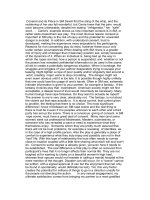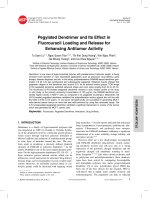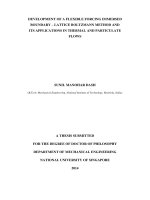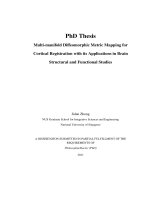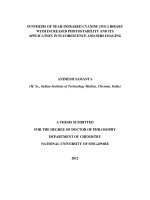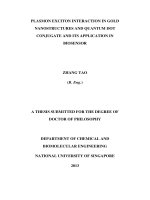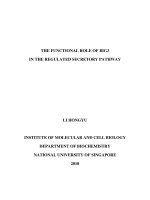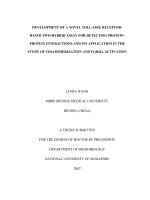Variability and genetic advance for seed yield and its components in castor (Ricinus communis L.) germplasm of Crida under rain-fed conditions in Alfisols
Bạn đang xem bản rút gọn của tài liệu. Xem và tải ngay bản đầy đủ của tài liệu tại đây (223.42 KB, 11 trang )
Int.J.Curr.Microbiol.App.Sci (2019) 8(1): 2001-2011
International Journal of Current Microbiology and Applied Sciences
ISSN: 2319-7706 Volume 8 Number 01 (2019)
Journal homepage:
Original Research Article
/>
Variability and Genetic Advance for Seed Yield and its Components in
Castor (Ricinus communis L.) Germplasm of CRIDA under Rain-Fed
Conditions in Alfisols
P. Sowmya*, M. Vanaja, V. Sunita and P. Raghuram Reddy
ICAR-CRIDA-Central Research Institute for Dryland Agriculture, Santoshnagar, Hyderabad500059, India
*Corresponding author
ABSTRACT
Keywords
Castor, Genotypes,
Seed yield, Genetic
variability, Genetic
advance
Article Info
Accepted:
14 December 2018
Available Online:
10 January 2019
Variability in seed yield of castor genotypes and its association between different yield
contributing traits as well as genetic advance were studied during kharif-2012 with 23
CRIDA castor genotypes under rain-fed conditions in alfisols. Superior genotypes for yield
and its components were identified. The variability for genotypes was significant for seed
yield and all its four components studied viz., number of branches, number of nodes,
capsule number and capsule weight. The correlation coefficient analysis revealed that seed
yield was highly significantly correlated with capsule number and capsule weight. High
heritability with high genetic advance as mean (GAM) was observed for capsule number,
capsule weight and seed yield, there by revealing that selection for high capsule number
and capsule weight will increase the seed yield in castor. Based on the seed yield
performance, twelve genotypes which yielded above 63.57g/pl (average yield of 23
genotypes) were selected for further evaluation of physiological efficiency coupled with
seed yield. It was observed that CRC-4 is the only genotype where in the range for five
characters was 2-6 ranks, thereby revealing that this is a desirable genotype with higher
ranks for all the five characters studied.
Introduction
Castor bean (Ricinus communis L.) is a
tropical non-edible oil yielding plant of high
commercial importance. Castor bean is a
monotypic species belonging to the family
Euphorbiaceae and has a wide range
distribution in both tropical and sub-tropical
regions (Dapke et al., 2016). India accounts
for a total production of 17.33 lakh tonnes
from an area of 11.05 lakh ha and a
productivity of 1568 kg/ha during 2014-2015
(Ramesh et al., 2016). Major castor growing
countries include India, Brazil, China, Russia
and Thailand (Nagesh Kumar et al., 2015).
India is largest producer of castor seed and
constitutes about 64% of total global
production.
In India, Telangana and Gujarat are well
known for castor production and productivity.
To develop high yielding castor genotypes that
2001
Int.J.Curr.Microbiol.App.Sci (2019) 8(1): 2001-2011
get fit into the present cropping system, it is
important to create the genetic variability for
the selection of desirable variant. Castor being
a deep rooted crop, it can extract water from
considerable depth in the soil. In India castor
is normally grown as rain-fed crop in both
kharif and rabi seasons.
As seed yield is the principal factor and
influenced by various characters directly and
indirectly, hence it is essential to know the
relationship between them in order to improve
the yield potential through its components
(Frageria and Kokli, 1997). In this direction,
maximum utilization of the desirable
characters for the development of an ideal
genotype is important in castor (Halilu, 2013).
In castor, most of the yield characters are
governed by quantitative genes which in turn
influenced by environment. Thus, the
efficiency of selection of castor becomes
lesser with increase in environmental effects
(Dhedi et al., 2010). In order to obtain
accurate results, the genotypes of castor have
to be evaluated over multilocations/seasons
(Patel and Jaimini, 1988). Hence, it is
necessary to evaluate the genetic variability
present across Ricinus communis germplasm
from different geographic regions (Hinckley,
2006). Thus, the identification of significant
yield contributing parameters are necessary
for improving the yield of castor and towards
this endeavor, 23 genotypes of castor from
CRIDA germplasm were evaluated at field
conditions. This identification of better lines
would be helpful in the process of improving
castor productivity and production.
Materials and Methods
Four hundred accessions of castor germplasm
were crossed for more than ten years during an
Indo-U.S. project at CRIDA. During Kharif2012, a field study was conducted with twenty
three CRIDA castor genotypes i.e., CRC-1,
CRC-2, CRC-3, CRC-4, CRC-5, CRC-6,
CRC-7, CRC-8, CRC-9, CRC-10, CRC-11,
CRC-12, CRC-13, CRC-14, CRC-15, CRC16, CRC-17, CRC-18, CRC-19, CRC-20,
CRC-21, CRC-22 and CRC-23at Hayathnagar
Research Farm, Central Research Institute for
Dryland
Agriculture
(ICAR-CRIDA),
Hyderabad,, the trial was sown on July 14th,
2012 in RBD with three replications. During
the crop growth period, the crop received 692
mm rainfall spreading in 36 rainy days (> 2.5
mm) and the crop experienced dry spell of
more than 10 days during initiation to
maturation of secondaries, and the rains
stopped from initiation of tertiaries onwards to
maturation of tertiaries.
The average temperature was 30.4°C with
minimum and maximum of 15.2°C and
40.0°C respectively (Table 1). Each genotype
was sown in 5m length of three rows with
plant to plant spacing of 30cm and 1m
between rows. At the time of harvest, the
observations were recorded on randomly
selected five plants from each replication of
individual genotype on number of branches up
to primaries, number of nodes up to primaries,
capsule number, capsule weight and seed yield
of three spikes orders i.e., primaries,
secondaries and tertiaries.
Genetic analysis
Heritability in broad sense (H2or h2)
(Falconer, 1989)
Phenotypic and genotypic correlations (Miller
et al., 1958)
Genotypic (σ2g) and Phenotypic variances
(σ2ph) (Comstock and Robinson, 1952).
Phenotypic Coefficient of Variation (PCV)
and Genotypic Coefficient of Variation (GCV)
(Singh and Chaudhary, 1985).
Statistical analysis - Analysis of variance
(ANOVA)- STAR (Statistical Tools For
Agricultural Research).
2002
Int.J.Curr.Microbiol.App.Sci (2019) 8(1): 2001-2011
Results and Discussion
Data on seed yield and its four components
i.e., number of nodes, number of branches
capsule number and capsule weight were
recorded for 23 CRIDA castor genotypes for
the three spike orders i.e., primaries (first
order), secondaries (second order) and
tertiaries (third order) during kharif-2012. The
mean performance of all the components is
presented in Table 2.
Yield and its components
5) with an average of 94.01g/pl. The high
yielding genotype, CRC-1 recorded capsule
weight of 150 g/pl.
The Analysis of Variance (ANOVA)
ANOVA showed highly significant variability
(p <0.01) among the genotypes for all the five
parameters studied viz., number of branches,
number of nodes up to primaries, capsule
number/pl, capsule weight /pl and seed yield
/pl and presented in Table 3.
Seed yield (grams per plant-g/pl)
Correlations
The seed yield of 23 CRIDA castor genotypes
ranged from 8.88 g/pl (CRC-23) to 107.4
g/pl(CRC-1) with an average of 63.57 g/pl.
Correlation studies provide the association of
seed yield with other traits. The genotypic (rG)
and phenotypic correlations (rP) of all the five
parameters are presented in Table 4. The rG
and rP of seed yield was highly significantly
and positively correlated for both capsule
weight (0.985 ** and 0.979**) and capsule
number (0.930** and 0.924**). Capsule
weight and capsule number have also showed
significant positive correlation with each other
with rG of 0.965** and rP of 0.959**
respectively. Number of nodes had significant
positive rG (0.462*) with the number of
branches.
Number of nodes up to primaries (per
plant-/pl)
The number of nodes ranged from 11 (CRC20) to 28.2 (CRC-17) with an average of
19.55/pl. The genotype CRC-1 with high seed
yield had 24.3 nodes.
Number of branches up to primaries (per
plant)
The number of branches ranged from 2.79
(CRC-16) to 7.75 (CRC-22) with an average
branches of 5.74 while CRC-1 recorded 5.56
branches.
Capsule number (per plant)
The capsules of three spike orders ranged
from 26.50 (CRC-23) to 225.00 (CRC-5) per
plant with an average of 117.13/pl. The high
yielding genotype, CRC-1 recorded 174.50
capsules /pl.
Capsule weight (g/pl)
The capsule weight of the genotypes ranged
from 15.00 g/pl(CRC-23) to 151.80 g/pl(CRC-
Genotypic and phenotypic variability,
heritability and genetic advance as percent
of mean (GAM %)
The variances, coefficient of variations,
heritability and genetic advance as percent of
mean (GAM) are presented in Table 5.
Genotypic and phenotypic variability
The phenotypic variance was higher than the
genotypic variance for all the traits. Highest
phenotypic variance was observed for capsule
number (2455.5) followed by capsule weight
(1778.8) and seed yield (860.3). Lowest
phenotypic variance was observed for number
2003
Int.J.Curr.Microbiol.App.Sci (2019) 8(1): 2001-2011
of branches (3.48). Similarly phenotypic coefficient of variation (PCV) was also higher
than genotypic co-efficient of variation (GCV)
for all the morphological and yield characters.
The highest PCV was found for seed yield
(46.14%) followed by capsule weight
(44.86%) capsule number (42.30%), number
of branches (32.50%) and number of nodes
(23.85%).
Heritability
High heritability was recorded for seed yield
(99.1%), followed by capsule number
(99.4%), capsule weight (99.4%), number of
nodes (84.1%) and moderate heritability was
observed for number of branches.
Genetic advance as percent of mean (GAM
%)
Genetic advance as percent of mean (GAM)
was highest for capsule number (115.57%),
followed by seed yield (94.17%), capsule
weight (91.88%), number of nodes (41.22%)
and number of branches (30.48%). High
heritability with high GAM was observed for
capsule number, capsule weight, number of
nodes (84.1, 41.22) and seed yield. High
heritability with high GAM was also observed
for. Moderate heritability with high GAM was
observed for number of branches (45.8, 30.4).
The ANOVA for yield and its attributes
revealed highly significant variability among
the twenty three genotypes studied for all the
five parameters viz., seed yield, number of
primary branches, number of nodes, capsule
number and capsule weight.
23 genotypes were classified for high,
moderate and low yielding based on values
obtained from seed yield. High yielding
genotypes ranking from 1 to 7 were classified
as high yielders and the yield ranged
from107.4 g/pl (1st rank) to 85.71 g/pl (7th
rank). Moderate yielding genotypes ranking 8
to 15 ranged from79 g/pl (8th rank) to 52.63
g/pl (15th rank). Low yielders ranking from 16
to 23 ranged from 44.34 g/pl (16th rank) to
8.88 g/pl (23rd rank).
From CRC-1 to CRC-7, other than seed yield,
out of the remaining four yield contributing
characters studied, it was observed that for
number of nodes, instead of 1 to 7 high ranks,
it was observed that only 3rd, 4th and 6th ranks
were observed for CRC-1, CRC-3, CRC-4
respectively, while 1st, 2nd, 5th and 7th ranks are
missing. However, for number of branches,
1st, 3rd, 4th, 5th and 7th ranks are missing for
CRC-1 to CRC-7. For capsule number, from
CRC-1 to CRC-7, 1st to 8th ranks were
observed with 2nd rank missing. Similarly, for
capsule weight, from CRC-1 to CRC-7, it was
observed that 7th rank is missing.
From the above results, it was observed that
CRC-4 is the only genotype where in the
range for five characters was 2-6 ranks,
thereby revealing that this is a desirable
genotype with higher ranks for all the five
characters studied. However, among the five
characters studied, the top 1-7 ranks for the
four characters was revealed by the genotypes
CRC-1, CRC-2, CRC-3, CRC-5 revealing that
these four genotypes were also desirable after
CRC-4. These results showed that the above
mentioned four genotypes were top rankers in
four characters while for one character (viz.,
number of nodes) it was moderate. From the
remaining high yielding genotypes viz., CRC6 and CRC-7, the results revealed that these
genotypes showed top ranking from 1-7 only
for one character viz., capsule weight for
former while capsule number for the later
respectively.
Similarly, for the genotypes CRC-8 to CRC15, it was observed that CRC-8, CRC-9, CRC12, CRC-13 and CRC-14 ranked between 6 to
15 ranks (moderate) for all the three characters
2004
Int.J.Curr.Microbiol.App.Sci (2019) 8(1): 2001-2011
studied revealing them to be moderate
genotypes. Whereas, CRC-10 was moderate
for only three characters (viz., capsule
number, capsule weight and number of nodes)
and CRC-11 was also moderate for only three
characters (viz., capsule number, capsule
weight and number of branches) while CRC15 was moderate for only two characters
studied (viz., capsule number& capsule
weight).
For the genotypes from CRC-16 to CRC-23, it
was observed that all these genotypes ranked
low (16-23) for two yield contributing
characters i.e., both capsule number and
capsule weight. While with number of nodes
and number of branches the genotypes ranked
variably with high, moderate and low
rankings.
Hence, from the above results of all the
genotypes for all the yield parameters studied,
it has clearly indicated that the higher seed
yield for all the genotypes was obtained due to
their higher capsule weight followed by
capsule number.
Maximum capsule weight/pl among the
different varieties in castor were obtained due
to genetic superiority and it even depends on
weather conditions (Koutroubas et al., 1999).
Koutroubas et al., (1999, 2000) suggested that
lower number of branches in three spike
orders resistant to shattering are desirable to
develop new varieties in castor.
Golakia et al., (2015) reported that less
number of nodes on main stem are the indirect
indicators of earliness. Aswani et al., (2003)
reported that capsule number is one of the
yield contributing traits in castor. Patel et al.,
(2016) suggested that number of capsules can
be taken into contemplation rather than
number of nodes up to primary spike for
improvements of seed yield in castor. Anastasi
et al., (2015) opined that according to the
variation in yield components of castor, seed
yield has changed substantially with genotype.
Gila and Manga (2015) reported that in castor
seed yield/plant varies with the variety.
Uguru (2000) recorded range of 90.2 to 507.2
g/pl of seed yield among six populations of
castor. Gobin et al., (2001) reported that the
mean seed yield ranged as from 500 kg/hain
India to 1000 kg/ha in Thailand and 2500
kg/ha under improved conditions in USA.
However, recent report showed that 554 kg/ha
was obtained in Brazil, 600 kg/ha in Russian
Federations, 621 kg/ha in Romania, 626 kg/ha
in Thailand, 667 kg/ha in Sudan, 700 kg/ha in
Ukraine, 909 kg/ha in China and 1,266 kg/ha
in India (FAO, 2000).
About 878 accessions were identified among
Indian collections for desirable traits with 70–
80 grams per 100 seed and high seed yield at
multiple harvests (Anjani and Hegde, 2007).
The average seed yields in India range from
1864 kg/ha in the State of Gujarat to 371
kg/hain the State of Andhra Pradesh, where
the crop has been predominantly grown
without irrigation on marginal soils (Basappa,
2007).
In Brazil, seed yields have averaged 667 kg/ha
over the last 10 yr (CONAB, 2011). The State
of Parana has the highest average seed yield in
the country (1600 kg/ha) due to better soil
fertility and agronomical practices (Silva et
al., 2009).
A positive relationship between yield and its
components indicates that any improvement in
one of the yield components would result in
concomitant increase in one or more
components (Adeyanju et al., 2010). Both
genotypic and phenotypic correlations were of
comparable magnitude, the genotypic
correlations of all the parameters studied were
higher than the phenotypic correlations
indicating that these characters were more
related genotypically.
2005
Int.J.Curr.Microbiol.App.Sci (2019) 8(1): 2001-2011
Table.1 Weather data during crop growth period- Kharif-2012
Average
Minimum
Maximum
Temperature
Max. (°C)
Min. (°C)
30.4
18.7
15.2
10.2
40.0
25.5
Total Rainfall = 692 mm
RH (relative humidity)
Max (%)
Min (%)
89.0
54.0
59.0
17.0
100.0
96.0
Number of rainy days (>2.5 mm) = 36 days
Table.2 Mean performance of yield and its components of 23 CRIDA castor genotypes during
Kharif-2012
Genotype
Seed Yield
(g/pl)
(Rk)
107.40 (1)
CRC-1
106.44 (2)
CRC-2
104.92 (3)
CRC-3
94.36 (4)
CRC-4
93.85 (5)
CRC-5
92.12 (6)
CRC-6
85.71 (7)
CRC-7
79.00 (8)
CRC-8
75.89 (9)
CRC-9
74.85 (10)
CRC-10
64.15 (11)
CRC-11
63.92 (12)
CRC-12
62.45 (13)
CRC-13
58.80 (14)
CRC-14
52.63 (15)
CRC-15
44.34 (16)
CRC-16
41.83(17)
CRC-17
34.57 (18)
CRC-18
34.00 (19)
CRC-19
30.92 (20)
CRC-20
25.98(21)
CRC-21
25.04 (22)
CRC-22
8.88 (23)
CRC-23
Average
63.57
Minimum 8.88
Maximum 107.4
Capsule
No./ pl
(Rk)
174.50 (3)
182.50 (2)
172.75 (4)
167.33 (5)
225.00 (1)
145.50 (8)
146.25 (7)
163.25 (6)
130.20 (9)
118.8 (10)
108.72 (13)
110.57 (11)
109.67(12)
106.50 (14)
103.78 (15)
77.67 (18)
99.46 (16)
45.11 (22)
58.03 (21)
62.00 (20)
77.17 (19)
82.83 (17)
26.50 (23)
117.13
26.5
225.0
Capsule
wt. (g/pl)
(Rk)
150.00 (2)
147.80 (4)
147.10 (5)
148.10 (3)
151.80 (1)
133.00 (6)
127.50 (8)
127.80 (7)
113.80 (9)
100.10 (10)
90.50 (13)
80.80 (15)
92.10 (12)
94.50 (11)
83.00 (14)
64.11 (16)
59.10 (17)
42.00 (21)
46.90 (20)
50.30 (18)
48.40 (19)
48.40 (19)
15.00 (22)
94.01
15.0
151.8
Nodes
No./pl
(Rk)
24.3(3)
18.0 (13)
24.1(4)
22.3(6)
16.0 (15)
11.8 (18)
19.7(11)
16.0 (15)
16.8 (14)
18.7 (12)
15.8 (16)
25.3(2)
16.0 (15)
19.8(10)
15.9 (17)
20.8 (7)
28.2 (1)
20.5 (8)
18.0 (13)
11.0 (19)
23.2(5)
22.3(6)
25.3(2)
19.55
11.0
28.2
1to7 ranks-high, 8 to15 ranks-moderate, 16 to 23 ranks -low
2006
Branches
No./ pl
(Rk)
5.56 (13)
7.50 (2)
6.06 (11)
7.50 (2)
6.75 (6)
3.00 (20)
4.83 (16)
6.00 (12)
7.04 (5)
4.33 (17)
5.00 (15)
6.33 (9)
7.16 (4)
6.17 (10)
4.09 (18)
2.79 (21)
7.30 (3)
5.14 (14)
3.33 (19)
5.00 (15)
6.72 (7)
7.75 (1)
6.67 (8)
5.74
2.79
7.75
Int.J.Curr.Microbiol.App.Sci (2019) 8(1): 2001-2011
Table.3 ANOVA for yield and yield parameters of 23 castor genotypes during Kharif-2012
Mean sum of squares
Source
Replication
Genotype
Error
DF
2
12
24
CV (%)
Seed yield
9.729
2565.4**
7.766
Capsule
number
37.246
7336.8**
14.879
Capsule
weight
1.247
5316.4**
9.934
Number of
nodes
3.291
58.4**
3.469
Number of
branches
0.355
6.670**
1.887
4.38
3.29
3.35
9.52
23.93
*Significance at p<0.05 and ** Significance at p <0.01
Table.4 Genotypic and phenotypic correlations of 23 CRIDA castor genotypes during Kharif2012
Seed yield
No. of
nodes
No. of
branches
Capsule
number
Capsule
weight
Seed yield
rG
rP
rG
rP
rG
-0.162
-0.143
0.069
0.046
0.930**
rP
rG
0.924**
0.985**
rP
rG
0.979**
1.00
rP
1.00
Capsule
number
-0.140
-0.122
0.266
0.192
1.00
Capsule
weight
-0.206
-0.188
0.122
0.103
0.965**
1.00
0.959**
1.00
No. of
nodes
1.00
1.00
No. of
branches
0.462*
0.337
1.00
1.00
1.00
*Significance at p<0.05 and ** Significance at p <0.01
Table.5 Co-efficient of variations, variances, heritability and GAM (%) for yield and yield
parameters of 23 CRIDA castor genotypes during Kharif-2012
Parameter
Genotypic Phenotypic
variance
variance
GCV
PCV
Heritability
GAM
(%)
Seed Yield
852.6
860.3
45.93
46.14
0.991
94.17
Capsule
Number
2440.6
2455.5
42.17
42.30
0.994
115.57
Capsule
Weight
1768.8
1778.8
44.73
44.86
0.994
91.88
No. of Nodes
No. of
Branches
18.30
1.594
21.78
3.48
21.87
21.99
23.85
32.50
0.841
0.458
41.22
30.48
2007
Int.J.Curr.Microbiol.App.Sci (2019) 8(1): 2001-2011
The rG and rP of seed yield was highly
significantly and positively correlated for both
capsule weight (0.985 ** and 0.979**) and
capsule number (0.930** and 0.924**) which
were in concurrence with the results of
Ahmed et al., (2012). Similarly, in the present
investigation, seed yield and number of
primary branches are correlated nonsignificantly and these results are in
agreement with the findings of Aghili et al.,
(2012) in Lentil. However, Sarwar et al.,
(2010) reported seed yield in castor had nonsignificant correlation with number of nodes.
Positive and significant genotypic correlation
was observed with number of nodes with
number of branches (Abimiku et al., 2012) in
castor.
Improvement of castor seed yield can
therefore, be achieved through selection of
these highly correlated characters as increase
in mean value of any one of these characters
would significantly increase the mean of
others (Patel et al., 2016). The variations that
existed among the genotypes in the yield
components showed that in castor, seed yield
could be improved through selection
programmes, if genetic information of these
characters is known (Gila and Manga, 2015).
While, looking into the estimates of GCV and
PCV, it was observed that PCV was greater
than GCV indicating the influence of
environment and hence phenotypic selection
can also be effectively useful for the crop
improvement (Patel et al., 2010). Higher
GCV and PCV were observed for capsule
number (2440.6 & 2455.5) followed by
capsule weight (1768.8 & 1778.8) and seed
yield (852.6& 860.3). Higher GCV and PCV
for seed yield, capsule number and capsule
weight in castor were reported by Udaya et
al., (2013) and Lakshmamma et al., (2005).
Heritability estimates along with genetic gains
are more effective and reliable in predicting
the improvement through selection (Johnson
et al., 1955). Heritability which denotes the
proportion
of
genetically
controlled
variability is very important biometrical tool
for guiding plant breeder for adoption of
appropriate breeding procedures. The
heritability value indicates the presence of
additive gene action and further improvement
in these traits could be effective through
direct selection (Jaimini, 2002). High
heritability coupled with high genetic
advance, indicate the presence of high
additive gene effects suggesting that direct
selection for the traits would be beneficial
(Panse, 1957). High heritability coupled with
moderate genetic advance in the character
indicates that the variability was due to both
additive and non-additive interaction of
genes. The characters exhibited low
heritability with moderate genetic advances
indicates a non-additive gene effect in
governing the characters. Low heritability
with low genetic advance indicate the
preponderance of non-additive gene action in
inheritance of the characters and high
influence of environment (John et al., 2016).
High heritability with high genetic advance as
mean (GAM) was observed for capsule
number, capsule weight and seed yield. These
results are in accordance with the findings of
Dhapke et al., (1992), Solanki and Joshi
(2000) with castor. Similarly high heritability
with high genetic advance mean was also
observed for number of nodes. Dorairaj et al.,
(1973) reported high heritability with high
genetic advance mean for number of nodes in
castor. Plant traits having high variability,
high heritability and genetic advance mean
would be an effective tool for crop
improvement (Aytac and Kinaci, 2009).
Hence, for the improvement of seed yield in
castor, selection for capsule number and
capsule weight could be given priority (Mehta
and Vashi, 1998). The emphasis of current
breeding programmes in India is mainly
2008
Int.J.Curr.Microbiol.App.Sci (2019) 8(1): 2001-2011
focused on high seed yield in castor (Lavanya
et al., 2006; Lavanya and Solanki, 2010)
since seed yield is the principal and
predominant factor for the development of an
ideal genotype, identification of significant
yield contributing parameters are necessary
for sustaining improved yield (Halilu et al.,
2013). Increased interaction between plant
breeders and geneticists with supporting
scientists such as molecular biologists, plant
physiologists,
plant
nutritionists,
entomologists, and plant pathologists would
speed the genetic improvement of castor
(Severino et al., 2012). Hence, these results
revealed that capsule number and capsule
weight are the most important traits for the
improvement of seed yield in castor.
Hence, these results revealed that capsule
number and capsule weight are the most
important traits for the improvement of seed
yield in castor.
In conclusion, twelve genotypes, out of 23
CRIDA genotypes were selected which
yielded above the average yield of 63.57 g/pl
for further evaluation. It was observed that
CRC-4 is the only genotype where in the
range for five characters was 2-6 ranks,
thereby revealing that this is a desirable
genotype with higher ranks for all the five
characters studied. The development of new
castor cultivars would be enhanced by
selecting capsule weight and capsule number
for increasing seed yield.
Acknowledgements
We acknowledge the Director, CRIDA and
Head, Division of Crop Sciences for
providing both field and lab facilities to
conduct experiments.
References
Abimiku, O.E., E.D. Azagaku, E. Ndor, 2012.
Genetic Variability and Correlation
Studies in Some Quantitative Characters
in Castor (Ricinus communis L.)
Accessions. Asian J. Agric. Sci4(6): 368372.
Adeyanju, A.O., A.Usman, S.G. Mohammed,
2010. Genetic Correlation and Pathcoefficient Analysis of Oil Yield and its
Components in Castor. Int. J. Appl. Agri.
Res. 5(2): 243–250.
Aghili, P., A.A. Imani, H. Shahbazi, Y. Alaei,
2012. Study of correlation and
relationships between seed yield and yield
components in Lentil (Lens culinaris
Medik). Ann. Biol. Res. 3 (11):50425045.
Ahmed H.M., G. Sarwar, M.A. Haq, 2012.
Genetic variability and interdependence
of morphological traits in castor bean
(Ricinus communis L.) mutants. Song. J.
Sci. Tech. 34(3): 279-286.
Anastasi U., O. Sortino, S.L. Cosentino, C.
Patanè, 2015. Seed yield and oil quality
of perennial castor bean in a
Mediterranean environment. Int. J. Pl.
Prod. 9 (1): 99-116.
Anjani, K., D.M. Hegde, 2007. Biodiversity in
indigenous castor. In: Kannaiyan S,
Venkatarmana K (Eds.), National
Consultation
Workshop
on
Agrobiodiversity Hot Spots and Access
and Benefit Sharing, pp. 42.
Aswani, K., R.S. Sangwan, D.S. Jatasra, 2003.
Correlation and path coefficient analysis
in castor (Ricinus communis L.) under
dryland conditions. Ind. J. Dryland Agri.
Res. Dev. 18: 89-91.
Aytac, Z.,G., Kinaci, 2009. Genetic variability
and association studies of some
quantitative characters in winter rapeseed
(Brassica napus L.). Afr. J. Biotech.
8(15):3547-3554.
Basappa, H., 2007. Validation of integrated pest
management modules for castor (Ricinus
communis) in Andra Pradesh. Ind. J. Agri.
Sci. 77:357–362.
CONAB 2011. Série histórica de safras:
Mamona. Companhia Brasileira de
Abastecimento, Brazil. ab.
gov.br.
2009
Int.J.Curr.Microbiol.App.Sci (2019) 8(1): 2001-2011
Dapke, J.S., M.R., Naik, G.B., Vaidya, P.B.,
Vanve, A.V., Narwade,B.K., Rajkumar,
2016. Genetic variability in castor
(Ricinus communis L.) European. J. of
Biotechnol. Biosci. 4(4): 39-40.
Dhapke, S.K., P.W., Khorgade, M.N.,
Narkhede, 1992. Estimation of genetic
variability in castor (Ricinus communis
L.). Agri. Sci. Dig. 12:141-143.
Dhedhi, K.K., Y.H., Ghelani, H.J., Joshi, C.J.,
Dangaria, 2010. Correlation and path coefficient analysis in castor (Ricinus
communis L.) over environments. Agri.
Sci. Dig. 30(4): 286- 289.
Dorairaj
S.M.,
M.,
Kandasami.,
S.
Palaniswamy,
S.,
Varisai,
1973.
Correlation studies in Ricinus communis
L. within inbreds and hybrids. Madras
Agric. 60 (9-12): 1481-1485.
FAO 2000. Castor: FAOSTAT. Statistical
Database Results 2000. Giriraj K,
Mensikai SW, Sindagi SS 1973.
Frageria M.S., and Kokli, U.K. 1997.
Correlation studies in tomato. Haryana J.
Hort. Sci. 25: 158-160.
Gila, N., A.G., Manga, 2015. Evaluation of
yield and yield components of castor
(Ricinus communis L.) germplasm from
rain forest and southern guinea savannah
agro-ecological zones of Int. J. of Curr.
Res. Acad. Rev. 3(6): 366-373.
Gobin, A.M.I., M.I., Uguru, J., Deckers, 2001.
Oil crop. In: Crop production in tropical
Africa. Romain H. Raemaekers (Ed.).
Brussels Belgium Director General for
International co-operation. pp. 725-733.
Golakia, P.R., V.K., Poshiya, B.A., Monpara,
2015. Identification of superior donor
parents for earliness through combining
ability in castor. Int. J. Res. in Plant Sci.
5(3): 26-31.
Halilu, A.D., D.A. Aba and J.O. Ogunwole,
2013. Genetic variability, genetic gain
and relationships of yield and yield
components in castor (Ricinus communis
L.). Res. Rev. in BioSci. 7(5): 181-186.
Hinckley, A.C. 2006. Genotyping and
bioforensics of Ricinus communis.
Lawrence
Livermore
National
Laboratory. UCRL-TH-226437.
Jaimini, N., 2002. Genetic variability,
association studies, genetic divergence
and stability analysis in newly evolved
pistillate lines of castor (Ricinus
communis L.). M.Sc. (Ag.) Thesis,
Gujarat
Agricultural
University,
Sardarkrushinagar (Gujarat).
John, K. and P. Raghava Reddy, 2016. Studies
on genetic parameters for yield and yield
attributes in groundnut (Arachis hypogaea
L.). Int. J. Recent Sci. Res. 7(5): 1115411156.
Johnson, H.W., H.E. Robinson and R.E.,
Comstock, 1955. Estimates of genetic and
environmental variability in soybean.
Agron. J. 47: 314-318.
Koutroubas S.D., D.K., Papakost, A., Doitsinis,
2000. Water requirements for castor oil
crop (Ricinus communis L) in a
Mediterranean climate. J. Agron. Crop
Sci. 184: 33-41.
Koutroubas, S.D., D.K. Papakosta, A.,
Doitsinis, 1999. Adaptation and yielding
ability of castor plant (Ricinus communis
L.) genotypes in a Mediterranean climate.
Eur. J. Agron. 11: 227-237
Lakshmamma, P., P. Lakshmi, Y. Chandra
Mohan, C. Lavanya, 2005. Genetic
variability and character association in
castor (Ricinus communis L.). Natl. J.
Plant Improv. 7(2): 122-126.
Lavanya, C., S.S. Solanki, 2010. Crop
improvement of castor. The challenges
ahead In: Hegde DM. (Ed.). Research and
development in castor. Present status and
future strategies. Indian Society of
Oilseeds Research, Hyderabad.
Lavanya, C., P.V.R. Rao, V.V. Gopinath, 2006.
Studies on combining ability and
heterosis for seed yield and yield
components in castor (Ricinus communis
L.) hybrids. J. Oil Seeds Res. 23:174-177.
Mehta, D.R., P.S. Vashi, 1998. Correlation and
path analysis of seed yield and its
components in castor. Ind. J. Agric. Res.
32(3):160-164.
Nagesh Kumar, M.V., V. Gouri Shankar, V.
Ramya,
P.
Bindu
Priya,
A.V.
2010
Int.J.Curr.Microbiol.App.Sci (2019) 8(1): 2001-2011
Ramanjaneyulu, G. Seshu, D. Vishnu
Vardhan Reddy, 2015. Enhancing castor
(Ricinus communis L.) productivity
through genetic improvement for
Fusarium wilt resistance-a review. Ind.
Crops Prod. 67:330–335.
Panse, V.G., 1957. Genetic of quantitative
character in selection plant breeding. Ind.
J. Gen. 17: 318-328.
Patel, J.K., D.B. Nakarani, 2016. Character
association and path analysis in castor
(Ricinus communis L.). Int. J. Agri. Sci.
12(1): 22-27.
Patel, J.R., M.P. Saiyed, C.G. Patel, R.K. Bhatt,
J.P. Bhatt, 2010. Genetic variability and
correlation studies in castor (Ricinus
communis L.). Int. J. Agri. Sci. 6(1): 129131.
Patel P.S., S.N., Jaimini, 1988. Variability in
castor (Ricinus communis L.). Ind. J.
Agri. Sci. 58 (5): 394-396.
Ramesh, T., A. Siva Sankar, J. Sreelakshmi, P.
Gouthami, C. Leela, Ch.V. Durga Rani,
V. Gouri Shankar, B. Lavanya, P.
Narayana Reddy, M.Y. Dudhe 2016.
Utilization of in silico EST–SSR markers
for diversity studies in castor (Ricinus
communis L.). Physiol. Mol. Biol. Plants.
DOI 10.1007/s12298-016-0367-x.
Sarwar, G., H.M. Ahmed, J. Hussain, 2010.
Evaluation of castor bean (Ricinus
communis L.) mutants for genetic
parameters and cluster analysis. J. Agri.
Res. 48(3): 289-301.
Severino, L.S., D.L. Auld, M. Baldanzi, M.J.D.
Candido, G. Chen, W. Crosby, X. He, D.
Tan, P. Lakshmamma, C. Lavanya,
O.L.T. Machado, T. Mielke, M. Milani,
T.D., Miller, J.B. Morris, S.A. Morse,
A.A. Navas, D.J. Soares, V. Sofiatti,
M.L., Wang, M.D., Zanotto, H., Zieler,
2012. A Review on the Challenges for
Increased Production of Castor. Agron. J.
104:853-880.
Silva, G.H., M.S.T. Esperancini, C.O. Melo,
O.C. Bueno, 2009. Production cost and
profitability of the castor oil plant in
western Paraná State. Informações
Econômicas 39:85–92.
Solanki, S.S., P. Joshi, 2000. Combining ability
analysis over environments of diverse
pistillate and male parents for seed yield
and other traits in castor (Ricinus
communis L.). Indian J. Genet. Pl. Br. 60:
201-212.
Udaya Bhanu, K., V. Satyanarayana Rao, M.
Srinivasa Rao, 2013. Genetic variability
in castor (Ricinus communis L.) for yield
and its contributing traits. Int. J Food,
Agric. Vet. Sci. 3(3): 103-108
Uguru, M.I., 2000. Genetic variability and
breeding value of castor genotypes.
Agron. Sci.1(1): 130-135.
How to cite this article:
Sowmya, P., M. Vanaja, V. Sunita and Raghuram Reddy, P. 2019. Variability and Genetic
Advance for Seed Yield and its Components in Castor (Ricinus communis L.) Germplasm of
CRIDA under Rain-Fed Conditions in Alfisols. Int.J.Curr.Microbiol.App.Sci. 8(01): 20012011. doi: />
2011
